Masahiro Tanaka: Yankees’ Tiger ace
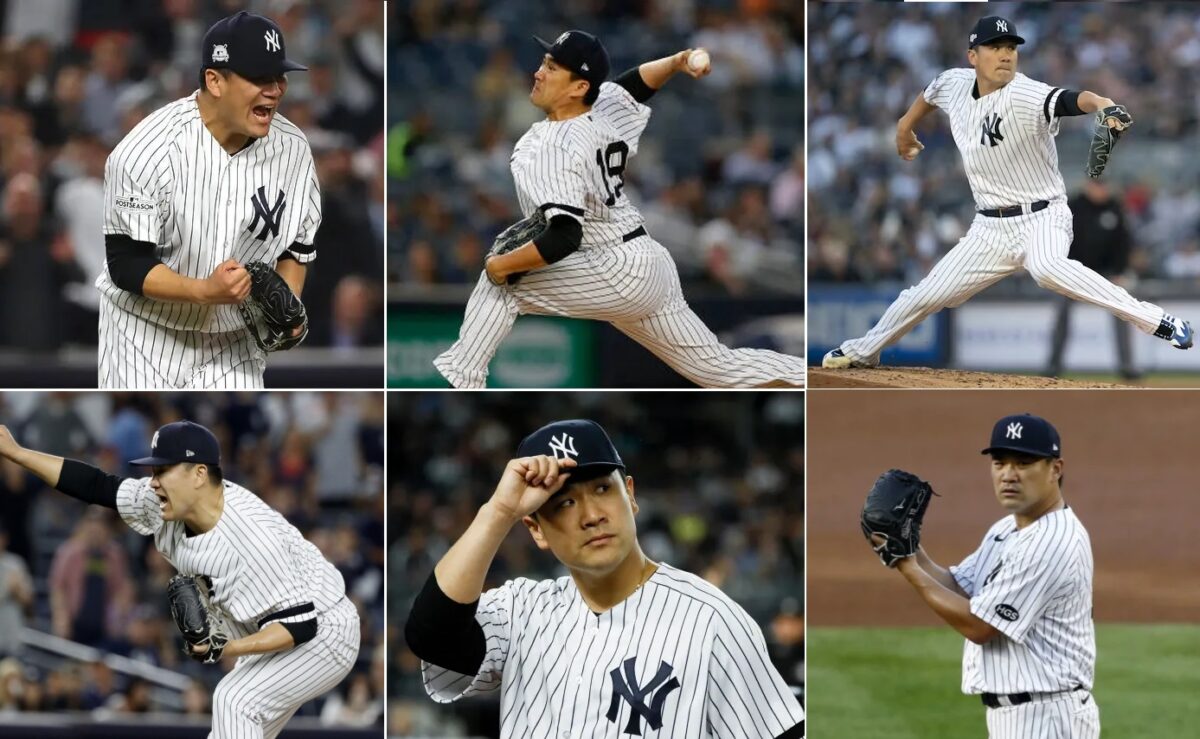
-
 Esteban Quiñones
Esteban Quiñones
- January 5, 2024
- 11:59 am
- No Comments
Table of Contents
| Position | Pitcher |
| Active years | MLB: 2014 – 2020NPB: 2007 – Present |
| Teams (years) | Tohoku Rakuten Golden Eagles (2007–2013) New York Yankees (2014–2020) Tohoku Rakuten Golden Eagles (2021–present) |
| Draft | 2006 NPB amateur player draft |
| Debut | NPB: March 29, 2007, for the Tohoku Rakuten Golden EaglesMLB: April 4, 2014, for the New York Yankees |
| Date of Birth | November 1, 1988 (age 35) |
| Native place | Itami, Hyōgo, Japan |
| Batted | Right |
| Threw | Right |
| All-Star | 8× NPB All-Star (2007–2009, 2011–2013, 2021, 2023)2× MLB 0All-Star (2014, 2019) |
| World Champions | Japan Series champion (2013) |
| AL MVP | Pacific League MVP (2013) |
| Shirt Number | No. 19 |
| MLB Awards | 2× Eiji Sawamura Award (2011, 2013) |
| 3× Golden Glove Award (2011–2013) | |
| 2013 PLCS MVP | |
| Nickname | “Ma-kun”, “Masa” |
The bio
Masahiro Tanaka burst onto the New York scene as a bona fide sensation from day one. Sporting a colossal $155 million contract, married to a rock star, and renowned for jet-setting in private Boeing 787s, he quickly became a celebrity of epic proportions. Beyond his off-field allure, Masahiro Tanaka’s prowess on the pitcher’s mound was nothing short of extraordinary. Whenever he took the field, television ratings soared, and stadiums brimmed with enthusiastic fans. He effortlessly assumed the role of MLB’s premier international attraction, injecting a fresh vitality the Yankees desperately needed. This demand for dignity, discipline, and confidence was especially crucial in the post-Rivera, farewell-to-Jeter, and A-Rod suspension era.
Emerging from an extraordinary spree of triumphs, tallying an impressive 30 consecutive victories with the Tohoku Rakuten Golden Eagles in Japan from 2012 to 2013, Masahiro Tanaka’s odyssey to the Yankees in 2014 unfolded as a cinematic blockbuster. Acquiring the 25-year-old pitching virtuoso carried a hefty price tag, with the Yankees forking over a staggering $20 million to the Golden Eagles merely for the privilege of negotiation. Nevertheless, Masahiro Tanaka justified every dollar spent as he seamlessly transitioned to the MLB, enrapturing the media, who chronicled his every appearance as if he were a veritable rock deity.
Caption: Source: AFP
Masahiro Tanaka’s grand debut on the New York stage, heralding his inaugural performance as a Yankee, played out with the same fervent anticipation typically reserved for the kickoff of a Beyoncé world tour. To elevate the spectacle, he commandeered an entire Japan Airlines Boeing 787, a move that came at a jaw-dropping cost of $195,000. This exclusive airborne voyage not only hosted Mr. and Mrs. Tanaka but also accommodated a Japanese baseball dignitary, two intimate confidants, and the cherished brown toy poodle of the couple, named Haru. Whispers of intriguing speculation circulated, suggesting that Japan Airlines might have generously offered the flight for the sake of publicity. Remarkably, by the fourth inning of his second start, the alleged expenses incurred had purportedly been effortlessly recouped.
In less than a mere two months into the season, Masahiro Tanaka stood on the brink of securing a massive fan following in the heart of New York. The Yankee faithful had already adopted the habit of collectively bellowing his nickname, “Ma-kun,” in unison as he made his way to the pitcher’s mound, establishing him as the beloved “Tiger Tanaka” in the lively chants echoing through the stands.
Early life and career
Masahiro Tanaka emerged into the world in the quaint town of Itami, a mere 12 miles from the bustling city of Osaka in western Japan. His journey into the realm of baseball commenced in the first grade, donning the catcher’s gear for the Koyanosato Tigers, a spirited Little League team. As he progressed, the landscape of his playing days expanded to include the Takarazuka Boys during his tenure at Itami Municipal Matsuzaki Junior High School. His versatility shone as he seamlessly transitioned between roles as a pitcher and catcher, a testament to his formidable throwing arm. The apex of his junior high school days saw him earning a coveted spot on the Junior All-South Kansai team during his third year, equivalent to the ninth grade in the United States.
Rather than pursuing his passion for baseball in the confines of his local high school, Masahiro Tanaka embarked on an arduous journey spanning over 900 miles. His destination: Komazawa Daigaku-fuzoku Tomakomai, affectionately known as plain Tomakomai to its devoted fans. This Hokkaidō-based institution was renowned for its rigorous baseball regimen, creating an environment akin to entering a sacred brotherhood for aspiring athletes. Life within the confines of this baseball-centric institution demanded an unwavering commitment to the team. The pursuit of perfection through relentless practice became the norm, with young athletes undergoing year-round training, often devoid of a single day off. After-school drills extended for seven grueling hours, where pitchers hurled balls up to 300 times in a day, and hitters swung their bats a thousand times. As the day concluded, the team dutifully tidied the field, retrieving stray baseballs, and meticulously raking the dirt to purify it from the indelible imprints of cleats.
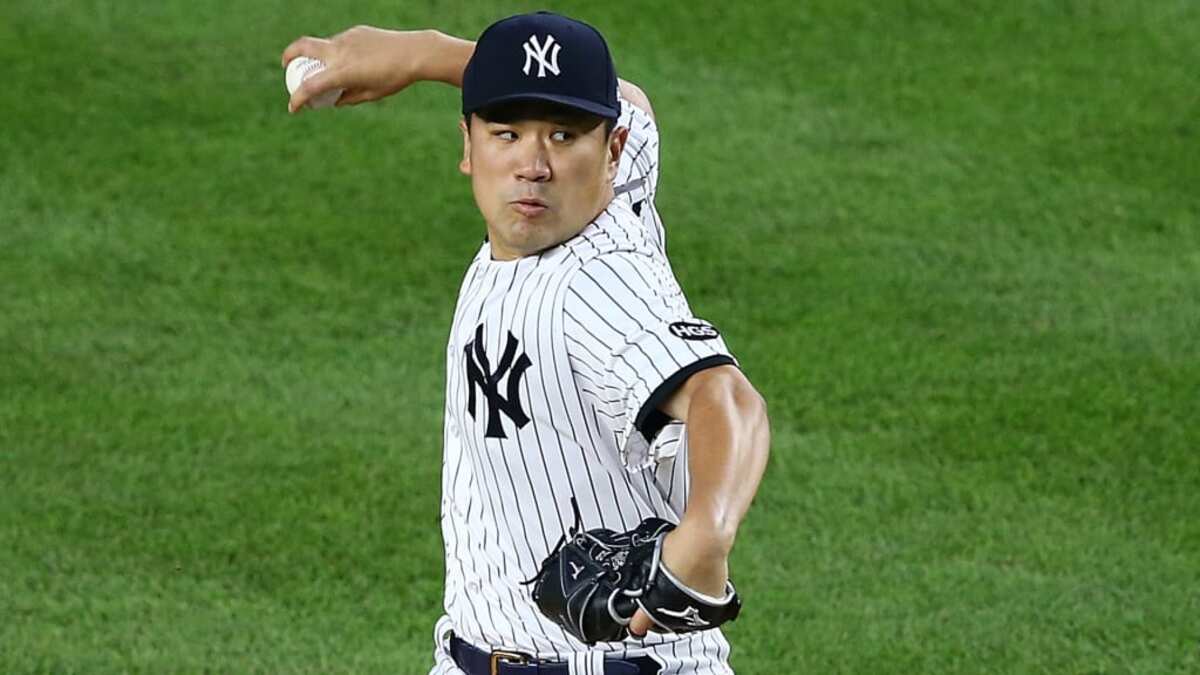
Emerging from an extraordinary spree of triumphs, tallying an impressive 30 consecutive victories with the Tohoku Rakuten Golden Eagles in Japan from 2012 to 2013, Masahiro Tanaka’s odyssey to the Yankees in 2014 unfolded as a cinematic blockbuster. Acquiring the 25-year-old pitching virtuoso carried a hefty price tag, with the Yankees forking over a staggering $20 million to the Golden Eagles merely for the privilege of negotiation. Nevertheless, Masahiro Tanaka justified every dollar spent as he seamlessly transitioned to the MLB, enrapturing the media, who chronicled his every appearance as if he were a veritable rock deity.
Masahiro Tanaka’s grand debut on the New York stage, heralding his inaugural performance as a Yankee, played out with the same fervent anticipation typically reserved for the kickoff of a Beyoncé world tour. To elevate the spectacle, he commandeered an entire Japan Airlines Boeing 787, a move that came at a jaw-dropping cost of $195,000. This exclusive airborne voyage not only hosted Mr. and Mrs. Tanaka but also accommodated a Japanese baseball dignitary, two intimate confidants, and the cherished brown toy poodle of the couple, named Haru. Whispers of intriguing speculation circulated, suggesting that Japan Airlines might have generously offered the flight for the sake of publicity. Remarkably, by the fourth inning of his second start, the alleged expenses incurred had purportedly been effortlessly recouped.
Masahiro Tanaka etched his name in the annals of high school baseball history, striking out 458 batters during his illustrious career from 2004 to 2006. This feat surpassed the previous national high school record of 423 held by Daisuke Matsuzaka from Yokohama Senior High School. Not content with just pitching excellence, Masahiro Tanaka also displayed his batting prowess by launching 13 home runs over the three years. As the 2006 NPB high school draft unfolded on September 25, the Hokkaido Nippon Ham Fighters, Orix Buffaloes, Yokohama BayStars, and Tohoku Rakuten Golden Eagles all vied for the chance to select the high school prodigy. In a twist of fate, the Golden Eagles emerged victorious, securing Masahiro Tanaka’s services with a base salary of 15 million yen, a signing bonus of 100 million yen, and additional performance-based incentives—a package equivalent to what a first-round college or industrial league player would typically receive. On November 2, he proudly donned the uniform number 18, symbolizing his designation as the team’s staff ace in Japanese professional baseball.
The Nippon League career
In the vibrant baseball tapestry of 2007, Masahiro Tanaka’s emergence onto the Eagles’ Michigan (the Japanese equivalent of the “major league”) roster during Spring training marked the genesis of his rookie odyssey. The curtains lifted on his professional debut on March 29, 2007, a spectacle that unfolded with mixed emotions. In a challenging outing, he conceded six runs on six hits and a walk in a mere 1⅔ innings. However, amidst the tumult, the Eagles orchestrated a spirited comeback, leveling the game in the fourth inning. A poignant image etched in memory captured Masahiro Tanaka seated in the dugout, tears streaming down his face after being relieved from the game.
Fast forward to April 18, a home game against the Hawks, where Masahiro Tanaka showcased his mettle. He held the opposing team to a mere two runs and delivered a commanding 13 strikeouts in a complete-game triumph—the inaugural victory of his professional career. A defining moment unfolded on June 13, as Tanaka mirrored the feats of Yu Darvish by hurling a complete-game shutout as a rookie fresh out of high school, in a showdown against the Chunichi Dragons. His meteoric rise continued as he secured another milestone, being the first pitcher since Daisuke Matsuzaka in 1999 to earn the coveted role of starting pitcher in the NPB All-Star Game, representing the Pacific League. In a dazzling display, he took the mound in Game 2 on July 22, reaching a personal high with a blistering pitch clocked at 153 km/h (95 mph).
Caption: Source: Twitter: @divingintof1rst
July 10th stood as a date adorned with yet another laurel for Masahiro Tanaka, as he etched his 100th strikeout of the season in a mere 96⅔ innings—an eloquent testament to his mastery on the mound. Culminating the season with an 11–7 record and a 3.82 ERA, Masahiro Tanaka’s inaugural campaign unfolded as a remarkable tale, crowning him with the coveted mantle of Pacific League Most Valuable Rookie. In a historical twist, he scripted his name as the first player straight out of high school to seize this esteemed award since the Matsuzaka era.
In the evolving saga of 2008, Masahiro Tanaka once more found himself inscribed at the forefront of the Eagles’ starting rotation for the consecutive second season. Yet, this chapter spun a nuanced storyline as he maneuvered through 24 starts—a subtle dip from the 28 outings in his rookie year. His playing time encountered interruptions, featuring a brief sojourn in the minors for shoulder inflammation rehabilitation and a commitment to the 2008 Beijing Olympics as a stalwart of the Japanese national team.
The dawn of 2009 unfurled Masahiro Tanaka as a dominant force. The early pages of the season painted a vivid tableau of his brilliance, with a four-hit complete-game shutout and a one-run complete-game triumph. Notably, the fourth conquest etched his name into the annals of history as the first pitcher since 1993 to embark on a season with four consecutive complete-game victories.
Fast forward to September 13, 2013, a pivotal moment in Masahiro Tanaka’s journey. On this date, he etched his name in the Nippon Professional Baseball (NPB) record books by securing his 21st consecutive win in the 2013 season, orchestrating a resounding 6–2 complete-game victory over the Orix Buffaloes. This triumph not only marked Masahiro Tanaka’s 25th consecutive win, inclusive of his final four starts in 2012 but also surpassed the hitherto unbroken record set by MLB legend Carl Hubbell with 24 consecutive wins in the 1936 and 1937 seasons. Concluding the regular season with an awe-inspiring 24–0 record and a minuscule 1.27 ERA, Tanaka ascended to receive his second Sawamura Award, a testament to his pitching prowess.
With the New York Yankees
During the illustrious 2013 season, MLB scouts cast their watchful eyes repeatedly on Masahiro Tanaka, recognizing the potential for a game-changing addition to their rosters. In a bold move orchestrated through the revised posting system, Rakuten presented Masahiro Tanaka to MLB during the offseason of 2013–14, commanding a substantial fee of $20 million on December 26, 2013. As the month-long anticipation unfolded, a constellation of MLB teams emerged as serious contenders, including the New York Yankees, Los Angeles Dodgers, Chicago Cubs, Chicago White Sox, Arizona Diamondbacks, and Houston Astros. The climax arrived on January 22, 2014, as Masahiro Tanaka penned his future with the Yankees, inking a seven-year contract valued at an impressive $155 million. This monumental agreement harbored an opt-out clause after the fourth year and a formidable full no-trade clause.

Stepping onto the grand proscenium of Major League Baseball, Masahiro Tanaka inaugurated his debut on April 4, 2014, squaring off against the Toronto Blue Jays. In a twist of poetic irony, he relinquished a home run to the opening batter—none other than the familiar countenance of ex-Yankee Melky Cabrera. Undaunted by this early setback, Masahiro Tanaka rallied, securing his maiden MLB victory. Unleashing a stellar performance encompassing seven innings pitched and eight strikeouts, he propelled the Yankees to a 7–3 triumph over the Blue Jays. His premier appearance on the home turf for the Yankees unfolded on April 9 against the Baltimore Orioles, where he showcased a virtuoso display, notching ten strikeouts in seven innings. Despite his brilliance, destiny dictated a no-decision as the Yankees succumbed to a narrow 5–4 defeat.
The unfolding narrative took a further twist in an interleague showdown with the New York Mets on May 14. Masahiro Tanaka left an indelible mark on the annals of MLB history, recording his inaugural major league hit off José Valverde while also orchestrating his maiden complete game in the majors. The Yankees emerged triumphant with a resounding 4–0 shutout against the Mets. Masahiro Tanaka sustained his winning streak, securing six victories before encountering his inaugural loss in MLB on May 20—a poignant moment as the Yankees succumbed to the Chicago Cubs with a scoreline of 6–1. This defeat marked Masahiro Tanaka’s first stumble in any professional baseball league since August 19, 2012.
As June unfolded, Masahiro Tanaka reached a significant milestone by notching his 100th strikeout of the season in a complete game against the Seattle Mariners. The pursuit of a shutout was curtailed when former Yankee Robinson Canó delivered a two-run home run in the ninth inning. Commencing the year with a stellar 11–1 record and a commendable 1.99 ERA in his initial 14 starts, Masahiro Tanaka asserted his dominance by striking out 113 batters in 99 innings. His exceptional performance earned him the distinction of becoming the first Yankees rookie to secure 12 wins by the All-Star break, earning him a well-deserved selection to the Major League Baseball All-Star Game as a reserve for the American League.
The narrative arc of Masahiro Tanaka’s journey took an unexpected twist on July 9, 2014, when he found himself sidelined due to right elbow inflammation, abruptly halting his stellar performance. His impressive record of 12–4 with a formidable 2.51 ERA in 18 starts hit a sudden roadblock. The injury forced his withdrawal from the All-Star Game, and an MRI revealed a partial tear in his UCL. Masahiro Tanaka, however, orchestrated a triumphant comeback on September 21 against the Blue Jays, clinching his 13th win in the Yankees’ 5–2 victory over their rivals. Wrapping up his inaugural major league season in 2014, Tanaka’s 20 starts yielded a 2.77 ERA with 141 strikeouts in 136+1⁄3 innings and a commendable 13–5 record.
The dawn of 2015 positioned Masahiro Tanaka as Joe Girardi’s choice for the opening-day starter for the Yankees on April 6 against the Blue Jays. However, this milestone encounter took an unexpected turn as he yielded five runs in the third inning, resulting in a defeat for the Yankees. Subsequently, on April 28, he found himself back on the disabled list, nursing forearm, and wrist soreness after four starts that garnered a 2–1 record and a 3.22 ERA. Challenges persisted in a June 27 start against the Houston Astros, where Masahiro Tanaka conceded a career-high six earned runs. Wrapping up the season with 24 starts, he achieved a 12–7 record with a 3.51 ERA in 154 innings, flaunting an impressive WHIP of 0.994—the lowest among all American League starters with at least 150 innings pitched. However, this accomplishment was tinged with the concession of 25 home runs.
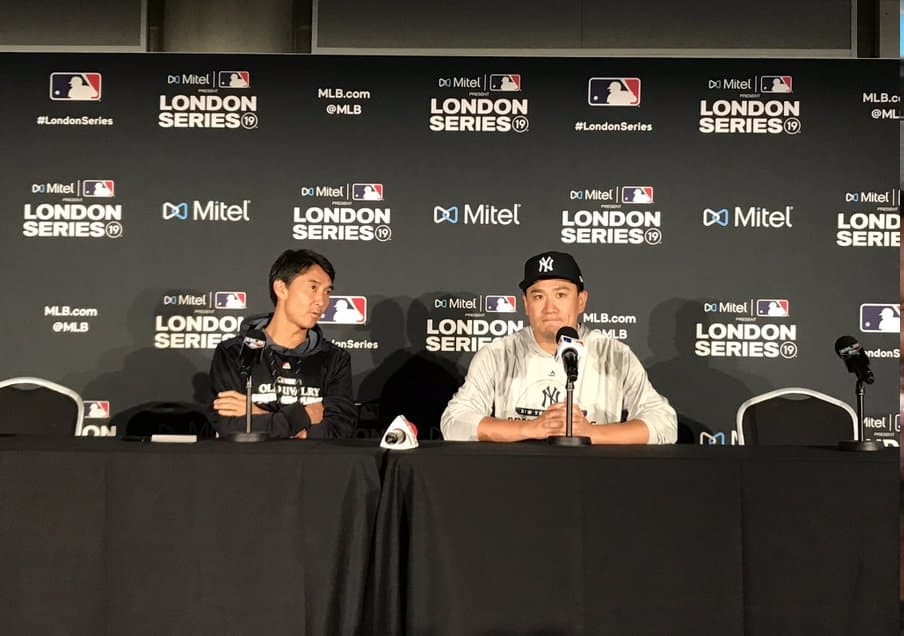
At the peak
The herald of 2016 saw Masahiro Tanaka at the helm for the Yankees’ Opening Day against the Houston Astros, where he surrendered two runs in 5+2⁄3 innings. Leading up to the All-Star Break, he notched a 6–2 record with a 3.23 ERA in 18 starts, covering 117 innings and striking out 93. In a pivotal Subway Series matchup on August 2 against the Mets, Masahiro Tanaka faced adversity, succumbing to a loss after giving up seven runs (six earned) in 6+1⁄3 innings. However, this would mark his final loss in 2016. The season’s latter half showcased his resilience as he clinched seven consecutive victories in his last ten starts. On September 10, he reached a zenith by striking out a season-high 10 batters in 7+1⁄3 innings against the Tampa Bay Rays. The second half of 2016 saw Masahiro Tanaka amassing an impressive 8–2 record with a 2.83 ERA in 13 games, delivering 82+2⁄3 innings and striking out 72.
In the transformative baseball season of 2016, Masahiro Tanaka notched a career pinnacle, making an unprecedented 31 starts and avoiding a stint on the disabled list—a first in his MLB career. The culmination of the year saw him amass 199+2⁄3 innings pitched, crafting a stellar 14–4 record, striking out 165 batters, and delivering an impressive 3.07 ERA—the third-best in the highly competitive American League. Masahiro Tanaka raised the bar by setting personal records in innings pitched, wins, strikeouts, and Wins Above Replacement (WAR), concluding the season with a noteworthy 5.4 WAR—the third-highest among all pitchers in the league. Recognizing his exceptional performance, he secured a tied seventh place in the American League Cy Young voting.
As the curtains rose in 2017, Masahiro Tanaka assumed the role of the Opening Day starter for the third consecutive season, a testament to his established status as a cornerstone of the Yankees’ pitching staff. The season’s inception unfolded at a measured pace until April 27, when he etched his name in history with a complete-game shutout against the Red Sox. The remarkable feat required only 97 pitches, earning him the colloquial distinction of a “Maddux”—a complete-game shutout with fewer than 100 pitches. This marked the first occurrence by any pitcher in the 2017 season. However, the narrative took an unexpected turn as Masahiro Tanaka encountered struggles in subsequent performances, prompting baseball analysts to unravel the mystery behind his downturn. Contrary to his stellar 2016 and his established reputation as the Yankees’ ace since 2014, Tanaka grappled with uncharacteristic challenges.
Injuries drove Masahiro Tanaka down
Speculation arose regarding potential injuries, with concerns of the need for Tommy John surgery lingering. Both the Yankees and Masahiro Tanaka himself vehemently asserted his full health. The crux of his tribulations rested on an unexpected vulnerability to the home run ball, conceding 21 home runs in the initial 76+2⁄3 innings of the season—nearly matching the total from the entire 2016 season, where he allowed 22 home runs.
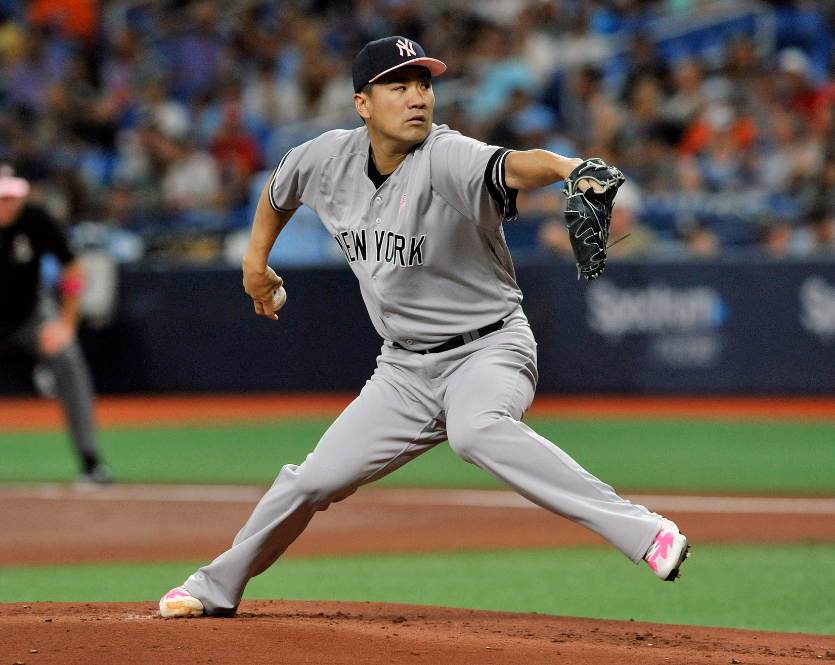
A breakthrough arrived on July 28, as Masahiro Tanaka set a new personal record by striking out an impressive 14 batters against the Rays. His dazzling performance included taking a perfect game into the sixth inning and allowing only one run on two hits in eight innings pitched. Further accolades awaited him on August 27, when he secured his tenth win of the season against the Seattle Mariners. This milestone made him the first Japanese pitcher in MLB history to achieve double-digit wins in each of his first four seasons. The regular season’s curtain call on September 29 saw Masahiro Tanaka once again elevate his game, setting a new career-high by striking out 15 batters against the Blue Jays. Concluding the 2017 season with 30 starts, he left an indelible mark with a 13–12 record, a 4.74 ERA, 194 strikeouts, and 35 home runs conceded in 178+1⁄3 innings pitched.
In the unfolding tapestry of 2018, Masahiro Tanaka embarked on his maiden start of the season with a grace that seamlessly blended finesse and mastery. The mound became a canvas as he gracefully retired 13 consecutive batters, striking out eight and allowing only a solitary one-run homer. The storyline took a delightful twist on June 8 at Citi Field against the Mets when Masahiro Tanaka notched his first career run, courtesy of an artful sacrifice fly from the towering presence of Aaron Judge.
The dawn of 2019 marked a pivotal shift, with Luis Severino’s rotator cuff injury opening the door for Masahiro Tanaka’s fourth Opening Day start on March 28. This start etched his name in the annals of history, securing the record for the most Opening Day starts by a Japanese pitcher. His virtuosity unfolded over 5+2⁄3 innings, surrendering six hits and two runs while striking out five, culminating in the Yankees’ resounding 7–2 triumph against the Orioles. June 17 marked a pinnacle as Tanaka orchestrated a mesmerizing complete game two-hit shutout, striking out 10 in the Yankees’ authoritative 3–0 victory against the Rays at Yankee Stadium. The accolades continued as Masahiro Tanaka earned a well-deserved spot in the 2019 Major League Baseball All-Star Game, stepping in as an injury replacement for Toronto Blue Jays pitcher Marcus Stroman on July 6.
However, the narrative took a somber turn on July 25 against the Red Sox, etching itself as Masahiro Tanaka’s most challenging outing in professional baseball. In a perplexing turn of events, he conceded 7 runs in the first inning and an additional 5 in the third, accumulating a staggering total of 12 runs—his highest in a single start. This tumultuous performance saw him retire only 10 hitters, including four strikeouts, marking the most earned runs allowed by a Yankees pitcher since the storied year of 1923.
In a fateful twist on July 4, 2020, Masahiro Tanaka faced a perilous moment when a line drive off Giancarlo Stanton’s bat struck him in the head during a practice game, resulting in a mild concussion. Displaying remarkable resilience, he defied the odds and made a triumphant return to the mound on August 1 against the Red Sox, showcasing his indomitable spirit. The culmination of the tumultuous year saw Masahiro Tanaka conclude with a 3–3 record and a commendable 3.56 ERA in 10 appearances, a testament to his unwavering commitment to the game.
As the curtain fell on the 2020 season, Masahiro Tanaka navigated a pivotal decision, choosing to chart a course back to Japan. The turning point materialized on January 28, 2021, as he and the Tohoku Rakuten Golden Eagles of Nippon Professional Baseball inked a historic two-year contract. Valued at 900 million yen ($8.6 million) annually with enticing incentives, this agreement crowned Masahiro Tanaka as the highest-paid player in NPB history.
The saga continued on January 7, 2023, when Masahiro Tanaka renewed ties with Rakuten, committing to a one-year contract for the 2023 season. Across 24 games, he etched a 7–11 record with a 4.91 ERA, delivering 81 strikeouts in a resilient display across 139+1⁄3 innings of diligent work. However, the narrative took a poignant turn on October 31 as Masahiro Tanaka underwent a right elbow cleanup surgery, currently convalescing from the procedure. The prevailing belief is that the Eagles will extend a winter posting for MLB teams, presenting an opportunity for Tanaka’s storied journey to resonate once again on the global stage.
The legacy
Masahiro Tanaka boasts an impressive array of pitches that paint a canvas of versatility on the mound. His four-seam fastball, with a cruising speed of around 90 mph and the capacity to reach a formidable 95 mph, stands as a testament to his prowess. Complementing this is his slider, a tight, biting offering that shares the limelight with the four-seamer. Averaging around 80 mph, the slider ascends to the high 80s, transcending its “get-me-over” status to emerge as a potent weapon against both left-handed and right-handed batters.
However, Masahiro Tanaka’s true pièce de résistance lies in his splitter, earning accolades as “arguably the best splitter in the world” according to Baseball America’s Ben Badler. Despite being thrown less frequently than his slider, the splitter reigns supreme as his premier strikeout pitch. With a mid-80s baseline that occasionally peaks into the low 90s, this pitch showcases substantial horizontal and vertical movement, confounding batters with its deceptive trajectory. Complementing his repertoire are a changeup, curveball, and cutter, though these play secondary roles in his overall pitching strategy. Among them, the curveball emerges as the standout, employed strategically to alter the eye level and timing of hitters, delivering its looping arc at approximately 70 mph.
Caption: Source: Twitter: @MLBStats
After a UCL (elbow) injury, Masahiro Tanaka embarked on a journey to reclaim his fastball velocity. Currently, he leans towards a two-seamer, deviating from the four-seam fastball that once held prominence in his arsenal. Beyond the diversity of his pitches, Masahiro Tanaka showcases impeccable command on the mound. Exhibiting a BB/9 (walks per nine innings rate) of 1.8 and a stellar K/BB (strikeout-to-walk ratio) of 4.76 in his MLB career, he navigates the strike zone with precision and finesse.
His greatest moments in pinstripes
Masahiro Tanaka’s Yankees legacy will be etched in memory for his standout performances during crucial moments and his ability to overcome obstacles, notably the partially torn ulnar collateral ligament that initially threatened his debut season but became a distant memory by the end of his tenure in pinstripes.
The debut delight, April 4, 2014, at Toronto
Despite initial nerves and a home run surrendered to Melky Cabrera, Masahiro Tanaka showcased his mettle in his debut, pitching seven strong innings and securing a 7-3 victory over the Blue Jays. Toronto manager John Gibbons acknowledged, “He’s the real deal.”
Toppling sale, April 27, 2017, at Boston
Embracing the underdog role against the formidable Chris Sale, Masahiro Tanaka delivered a masterful ‘Maddux’ performance with a 97-pitch complete game, retiring the last 14 Boston batters and allowing only one runner to reach second base. He humbly stated, “A lot of people thought Chris Sale had the upper hand.”
October heroics, October 8, 2017, vs. Cleveland
Facing a 2-0 deficit in the AL Division Series, Masahiro Tanaka electrified Yankee Stadium with a seven-inning gem, outdueling Carlos Carrasco and helping the Yankees stay alive. His stellar effort, complemented by a crucial Aaron Judge catch, contributed to the team’s victory.
World Series doorstep, October 18, 2017, vs. Astros
In a pivotal AL Championship Series game, Masahiro Tanaka pitched seven gutsy innings against the Astros, securing a 3-2 series lead. Displaying rare emotion, his strikeouts of George Springer and Josh Reddick with two men on demonstrated his tenacity and determination.
Pitching precision, June 17, 2019, vs. Rays
Among Masahiro Tanaka’s impressive double-digit-strikeout games, a standout performance occurred on June 17, 2019, against the Rays. Pitching a career-best two-hitter, he struck out 10 in a 3-0 victory, showcasing impeccable precision with 76 of 111 pitches for strikes and a career-best ‘game score’ of 92. True to form, Masahiro Tanaka remained modest, stating his pitches “weren’t as sharp as I want them to be.”
Awards and honors
Nippon Professional Baseball (NPB) Achievements
- Pacific League Rookie of the Year (2007)
- Pacific League MVP (2013)
- 2013 PLCS MVP
- 8× NPB All-Star (2007–2009, 2011–2013, 2021, 2023)
- 2× Eiji Sawamura Award (2011, 2013)
- 2× NPB wins champion (2011, 2013)
- 2× NPB ERA champion (2011, 2013)
- NPB strikeout champion (2012)
- 2× Best Nine Award (2011, 2013)
- 3× Golden Glove Award (2011–2013)
- Japan Series champion (2013)
- Japan Professional Sports Grand Prize (2013)
Major League Baseball (MLB) Achievements
- 2× MLB All-Star (2014, 2019)
Masahiro Tanaka FAQs
Why did Masahiro Tanaka leave the Yankees?
Masahiro Tanaka left the New York Yankees and returned to Japan due to safety concerns for himself and his family, stemming from a spike in discrimination and hate crimes against the Asian community since the COVID-19 outbreak.
What happened to Masahiro Tanaka?
Masahiro Tanaka left the USA and returned to Japan due to safety concerns for himself and his family, as well as a discriminatory episode experienced by his son in school[1][2][3].
Where is Masahiro Tanaka now?
Masahiro Tanaka is now in Japan, having returned from the USA].
When did Masahiro Tanaka’s Yankees contract end?
Masahiro Tanaka’s contract with the New York Yankees ended after the 2020 season.
How long has Masahiro Tanaka been playing baseball?
Masahiro Tanaka has been playing professional baseball for over 15 years. He started with the Tohoku Rakuten Golden Eagles in 2007 and played with them until 2013. Tanaka then joined the New York Yankees from 2014 to 2020 before returning to the Tohoku Rakuten Golden Eagles in 2021, where he continued his career.
Masahiro Tanaka how long in MLB?
Masahiro Tanaka played in the MLB for seven seasons. He joined the New York Yankees in 2014 and played with them until the end of the 2020 season. After leaving the Yankees, he returned to Japan to play for the Tohoku Rakuten Golden Eagles.
How fast does Masahiro Tanaka pitch?
Masahiro Tanaka is known for his impressive pitching speed. His fastball typically ranges from 91-94 mph, and he also has a devastating splitter in his pitching arsenal.
How good is Masahiro Tanaka?
Masahiro Tanaka is a talented and experienced pitcher known for his strong performance, particularly in big games. He was a valuable asset to the teams he has played for, including the New York Yankees.
Masahiro Tanaka why did he leave?
Masahiro Tanaka left the USA and the New York Yankees due to safety concerns for himself and his family, as well as a discriminatory episode experienced by his son in school.
Masahiro Tanaka where is he from?
Masahiro Tanaka is from Itami, Hyogo, Japan.
How did Masahiro Tanaka make the All-Star game?
Masahiro Tanaka made the All-Star game based on his strong performance and skill as a pitcher. His impressive pitching abilities and contributions to the New York Yankees likely played a significant role in his All-Star game selection.
What team is Masahiro Tanaka on?
As of the latest information available, Masahiro Tanaka is playing for the Tohoku Rakuten Golden Eagles in Japan. He joined the team after leaving the New York Yankees.
Why doesn’t Masahiro Tanaka have many wins?
Masahiro Tanaka’s win-loss record may be influenced by various factors, including run support, performance of the team, and individual performance. It is important to consider a range of factors when evaluating a pitcher’s win-loss record.
Why does Masahiro Tanaka take his hat off after every inning?
Masahiro Tanaka’s habit of taking his hat off after every inning is a personal superstition or routine. Many players have individual habits or rituals that they follow during games.
How much is a Masahiro Tanaka rookie card worth?
The value of a Masahiro Tanaka rookie card can vary based on factors such as its condition, rarity, and demand among collectors. It is recommended to consult a reputable source for sports card values or auctions to determine the current worth of a specific card.
Where was Masahiro Tanaka born?
Masahiro Tanaka was born in Itami, Hyogo, Japan.
Why did Masahiro Tanaka not pitch for game 7?
Masahiro Tanaka did not pitch in Game 7 of the 2017 ALCS due to concerns about his physical condition. Despite his stellar performance in Game 5, where he threw 104 pitches over seven scoreless innings, the Yankees chose not to use him in relief on two days’ rest for Game 7. Manager Joe Girardi expressed reservations about pushing Tanaka, citing a partially torn elbow ligament he suffered in 2014 and the team’s cautious approach to managing his workload. The Yankees opted to rely on their bullpen, emphasizing the use of relievers over starting pitchers in crucial situations.
How old is Masahiro Tanaka?
Masahiro Tanaka was born on November 1, 1988, so he is currently 35 years old.
Where does Masahiro Tanaka live?
As of the most recent information, Masahiro Tanaka is in Japan, having returned from the USA.
Why was Masahiro Tanaka a mistake?
The assessment that Masahiro Tanaka was a mistake is likely attributed to concerns about his control issues, particularly with his slider and splitter. Critics pointed out that in recent starts, batters let his pitches go for ball four too frequently. Additionally, Tanaka’s performance was noted as weaker when he is behind in the count or with runners on base, contributing to the perception that his pitching may not be meeting expectations.
Why did Masahiro Tanaka retire?
Masahiro Tanaka did not officially retire from MLB but left the United States due to safety concerns related to discrimination against Asians amid the COVID-19 pandemic. Additionally, he felt ignored by the New York Yankees during contract negotiations and returned to Japan, signing a two-year deal with the Tohoku Rakuten Golden Eagles in response to these factors.
Was Masahiro Tanaka good?
Masahiro Tanaka is widely regarded as a talented and skilled pitcher, known for his strong performance, particularly in big games.
What pitches did Masahiro Tanaka throw?
Masahiro Tanaka is known for his impressive pitching repertoire, which includes a fastball, splitter, slider, and occasional curveball.
Where is Tanaka now?
Tanaka is currently in Japan, having returned from the USA.
What is the prognosis for Masahiro Tanaka?
Masahiro Tanaka’s prognosis involved elbow cleanup surgery with a projected 4-month recovery period.
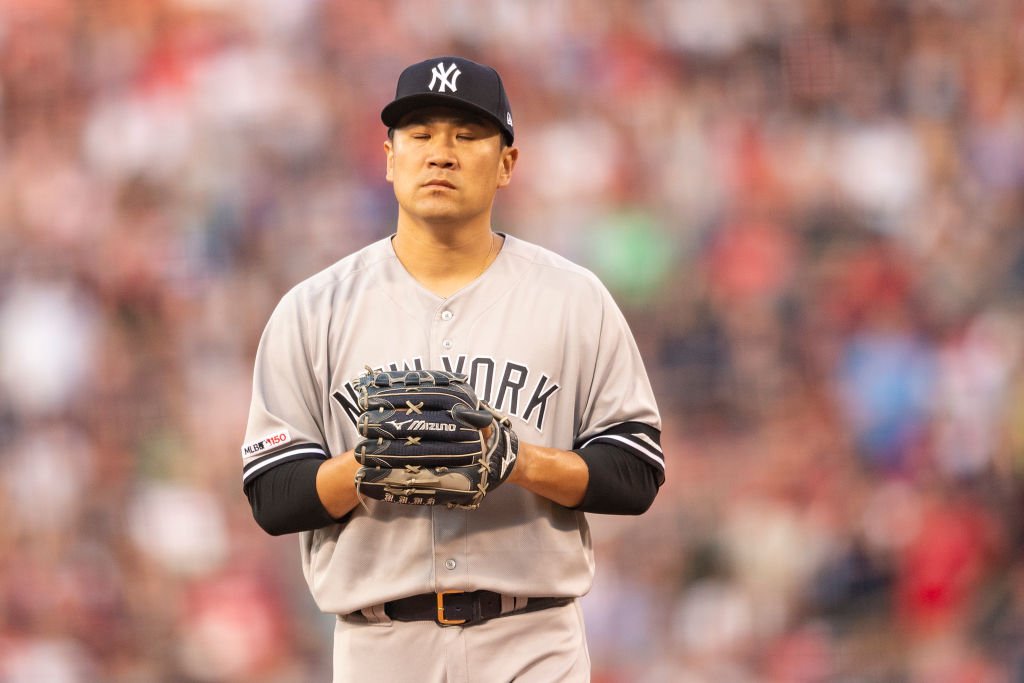
Masahiro Tanaka stats
| SUMMARY | WAR | W | L | ERA | G | GS | SV | IP | SO | WHIP |
| Career | 17.3 | 78 | 46 | 3.74 | 174 | 173 | 0 | 1054.1 | 991 | 1.13 |
Standard pitching
| Year | W | L | W-L% | ERA | G | GS | GF | CG | SHO | SV | IP | H | R | ER | HR | BB | IBB | SO | HBP | BK | WP | BF | ERA+ | FIP | WHIP | H9 | HR9 | BB9 | SO9 | SO/W |
| 2014 | 13 | 5 | 0.722 | 2.77 | 20 | 20 | 0 | 3 | 1 | 0 | 136.1 | 123 | 47 | 42 | 15 | 21 | 0 | 141 | 4 | 0 | 4 | 542 | 138 | 3.04 | 1.056 | 8.1 | 1 | 1.4 | 9.3 | 6.71 |
| 2015 | 12 | 7 | 0.632 | 3.51 | 24 | 24 | 0 | 1 | 0 | 0 | 154 | 126 | 66 | 60 | 25 | 27 | 0 | 139 | 1 | 0 | 4 | 609 | 116 | 3.98 | 0.994 | 7.4 | 1.5 | 1.6 | 8.1 | 5.15 |
| 2016 | 14 | 4 | 0.778 | 3.07 | 31 | 31 | 0 | 0 | 0 | 0 | 199.2 | 179 | 75 | 68 | 22 | 36 | 0 | 165 | 3 | 0 | 7 | 805 | 140 | 3.51 | 1.077 | 8.1 | 1 | 1.6 | 7.4 | 4.58 |
| 2017 | 13 | 12 | 0.52 | 4.74 | 30 | 30 | 0 | 1 | 1 | 0 | 178.1 | 180 | 100 | 94 | 35 | 41 | 1 | 194 | 7 | 0 | 7 | 752 | 95 | 4.34 | 1.239 | 9.1 | 1.8 | 2.1 | 9.8 | 4.73 |
| 2018 | 12 | 6 | 0.667 | 3.75 | 27 | 27 | 0 | 1 | 1 | 0 | 156 | 141 | 68 | 65 | 25 | 35 | 0 | 159 | 7 | 0 | 3 | 635 | 112 | 4.01 | 1.128 | 8.1 | 1.4 | 2 | 9.2 | 4.54 |
| 2019 | 11 | 9 | 0.55 | 4.45 | 32 | 31 | 0 | 1 | 1 | 0 | 182 | 186 | 95 | 90 | 28 | 40 | 0 | 149 | 2 | 0 | 7 | 759 | 100 | 4.27 | 1.242 | 9.2 | 1.4 | 2 | 7.4 | 3.73 |
| 2020 | 3 | 3 | 0.5 | 3.56 | 10 | 10 | 0 | 0 | 0 | 0 | 48 | 48 | 25 | 19 | 9 | 8 | 0 | 44 | 2 | 0 | 0 | 197 | 120 | 4.42 | 1.167 | 9 | 1.7 | 1.5 | 8.3 | 5.5 |
| 7 Years | 78 | 46 | 0.629 | 3.74 | 174 | 173 | 0 | 7 | 4 | 0 | 1054.1 | 983 | 476 | 438 | 159 | 208 | 1 | 991 | 26 | 0 | 32 | 4299 | 114 | 3.91 | 1.13 | 8.4 | 1.4 | 1.8 | 8.5 | 4.76 |
| 162 Game Average | 15 | 9 | 0.629 | 3.74 | 34 | 34 | 0 | 1 | 1 | 0 | 207 | 193 | 93 | 86 | 31 | 41 | 0 | 194 | 5 | 0 | 6 | 842 | 114 | 3.91 | 1.13 | 8.4 | 1.4 | 1.8 | 8.5 | 4.76 |
| W | L | W-L% | ERA | G | GS | GF | CG | SHO | SV | IP | H | R | ER | HR | BB | IBB | SO | HBP | BK | WP | BF | ERA+ | FIP | WHIP | H9 | HR9 | BB9 | SO9 | SO/W |
Postseason pitching
| Year | W | L | W-L% | ERA | G | GS | GF | CG | SHO | SV | IP | H | R | ER | HR | BB | IBB | SO | HBP | BK | WP | BF | WHIP | H9 | HR9 | BB9 | SO9 | SO/W | WPA | cWPA |
| 2015 | 0 | 1 | 0 | 3.6 | 1 | 1 | 0 | 0 | 0 | 0 | 5 | 4 | 2 | 2 | 2 | 3 | 0 | 3 | 0 | 0 | 0 | 21 | 1.4 | 7.2 | 3.6 | 5.4 | 5.4 | 1 | 0 | -0.10% |
| 2017 | Did not pitch in series | |||||||||||||||||||||||||||||
| 2017 | 1 | 0 | 1 | 0 | 1 | 1 | 0 | 0 | 0 | 0 | 7 | 3 | 0 | 0 | 0 | 1 | 0 | 7 | 0 | 0 | 0 | 23 | 0.571 | 3.9 | 0 | 1.3 | 9 | 7 | 0.46 | 2.70% |
| 2017 | 1 | 1 | 0.5 | 1.38 | 2 | 2 | 0 | 0 | 0 | 0 | 13 | 7 | 2 | 2 | 0 | 2 | 0 | 11 | 0 | 0 | 2 | 49 | 0.692 | 4.8 | 0 | 1.4 | 7.6 | 5.5 | 0.37 | 8.40% |
| 2018 | Did not pitch in series | |||||||||||||||||||||||||||||
| 2018 | 1 | 0 | 1 | 1.8 | 1 | 1 | 0 | 0 | 0 | 0 | 5 | 3 | 1 | 1 | 1 | 1 | 0 | 4 | 0 | 0 | 0 | 19 | 0.8 | 5.4 | 1.8 | 1.8 | 7.2 | 4 | 0.19 | 1.90% |
| 2019 | 1 | 0 | 1 | 1.8 | 1 | 1 | 0 | 0 | 0 | 0 | 5 | 3 | 1 | 1 | 0 | 1 | 0 | 7 | 1 | 0 | 0 | 19 | 0.8 | 5.4 | 0 | 1.8 | 12.6 | 7 | 0.17 | 1.50% |
| 2019 | 1 | 1 | 0.5 | 2.45 | 2 | 2 | 0 | 0 | 0 | 0 | 11 | 5 | 4 | 3 | 1 | 3 | 0 | 5 | 0 | 0 | 0 | 40 | 0.727 | 4.1 | 0.8 | 2.5 | 4.1 | 1.67 | 0.26 | 3.70% |
| 2020 | 0 | 0 | 13.5 | 1 | 1 | 0 | 0 | 0 | 0 | 4 | 5 | 6 | 6 | 0 | 3 | 0 | 3 | 0 | 0 | 0 | 20 | 2 | 11.3 | 0 | 6.8 | 6.8 | 1 | -0.3 | -1.90% | |
| 2020 | 0 | 1 | 0 | 11.25 | 1 | 1 | 0 | 0 | 0 | 0 | 4 | 8 | 5 | 5 | 2 | 1 | 0 | 4 | 0 | 0 | 0 | 21 | 2.25 | 18 | 4.5 | 2.3 | 9 | 4 | -0.31 | -4.20% |
| W | L | W-L% | ERA | G | GS | GF | CG | SHO | SV | IP | H | R | ER | HR | BB | IBB | SO | HBP | BK | WP | BF | WHIP | H9 | HR9 | BB9 | SO9 | SO/W | WPA | cWPA | |
| 5 Yrs (8 Series) | 5 | 4 | 0.556 | 3.33 | 10 | 10 | 0 | 0 | 0 | 0 | 54 | 38 | 21 | 20 | 6 | 15 | 0 | 44 | 1 | 0 | 2 | 212 | 0.981 | 6.3 | 1 | 2.5 | 7.3 | 2.93 | 0.85 | 12.00% |
| 2 ALWC | 0 | 1 | 0 | 8 | 2 | 2 | 0 | 0 | 0 | 0 | 9 | 9 | 8 | 8 | 2 | 6 | 0 | 6 | 0 | 0 | 0 | 41 | 1.667 | 9 | 2 | 6 | 6 | 1 | -0.3 | -2.00% |
| 4 ALDS | 3 | 1 | 0.75 | 3 | 4 | 4 | 0 | 0 | 0 | 0 | 21 | 17 | 7 | 7 | 3 | 4 | 0 | 22 | 1 | 0 | 0 | 82 | 1 | 7.3 | 1.3 | 1.7 | 9.4 | 5.5 | 0.51 | 1.90% |
| 2 ALCS | 2 | 2 | 0.5 | 1.88 | 4 | 4 | 0 | 0 | 0 | 0 | 24 | 12 | 6 | 5 | 1 | 5 | 0 | 16 | 0 | 0 | 2 | 89 | 0.708 | 4.5 | 0.4 | 1.9 | 6 | 3.2 | 0.63 | 12.10% |
Career graph
| All-Star Games | Cy Young (rank, share) | Monthly Awards | WAR for Pitchers |
| 2014 2019 * | 2016 AL (7, 3%) 0.03 Career Shares (321st) | 2014 May AL Pitcher of the Month | 2016 AL 5.2 (5th) |
| Earned Run Average | Win-Loss % | Walks & Hits per IP | Hits per 9 IP |
| 2016 AL 3.07 (3rd) | 2014 AL .722 (6th) 2016 AL .778 (4th) Career .629 (65th) | 2016 AL 1.077 (5th) Career 1.130 (47th) | 2016 AL 8.068 (9th) |
| Bases On Balls per 9 IP | Strikeouts per 9 IP | Innings Pitched | Strikeouts |
| 2016 AL 1.623 (3rd) 2017 AL 2.069 (3rd) 2019 AL 1.978 (3rd) Career 1.776 (50th) | 2017 AL 9.791 (7th) Career 8.459 (53rd) | 2016 AL 199.7 (10th) | 2017 AL 194 (8th) |
| Complete Games | Shutouts | Home Runs | Strikeouts / Base On Balls |
| 2014 AL 3 (2nd) 2017 AL 1 (5th) 2018 AL 1 (5th) 2019 AL 1 (7th) | 2014 AL 1 (5th) 2017 AL 1 (3rd) 2018 AL 1 (1st) 2019 AL 1 (3rd) | 2015 AL 25 (9th) 2017 AL 35 (3rd) | 2016 AL 4.583 (4th) 2017 AL 4.732 (4th) 2019 AL 3.725 (9th) Career 4.764 (5th) |
| Home Runs per 9 IP | Losses | Earned Runs | Adjusted ERA+ |
| 2016 AL 0.992 (9th) | 2017 AL 12 (10th) | 2017 AL 94 (10th) 2019 AL 90 (9th) | 2016 AL 140 (4th) |
| Fielding Independent Pitching | Adj. Pitching Runs | Adj. Pitching Wins | Base-Out Runs Saved (RE24) |
| 2016 AL 3.51 (5th) | 2016 AL 26 (6th) | 2016 AL 2.7 (5th) | 2016 AL 29.84 (6th) |
| Win Probability Added (WPA) | Sit. Wins Saved (WPA/LI) | Base-Out Wins Saved (REW) | Assists as P |
| 2016 AL 3.1 (6th) | 2016 AL 3.0 (4th) | 2016 AL 3.1 (6th) | 2016 AL 30 (3rd) 2018 AL 24 (4th) |
| Double Plays Turned as P | Range Factor/9Inn as P | Range Factor/Game as P | Fielding % as P |
| 2018 AL 4 (2nd) 2019 AL 3 (3rd) | 2016 AL 1.85 (4th) | 2016 AL 1.32 (3rd) | 2017 AL 1.000 (1st) |
| Salary | |||
| 2014 AL $22,000,000 (8th) 2019 AL $22,000,000 (10th) |
Source: Baseball-Reference
- Categories: Masahiro Tanaka
- Tags: Masahiro Tanaka
Related posts:


 Follow Us
Follow Us





